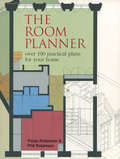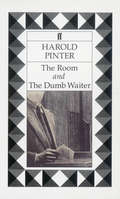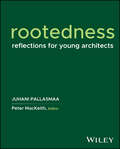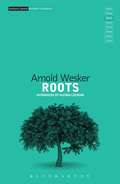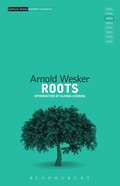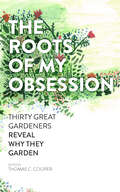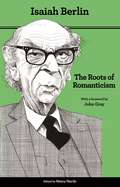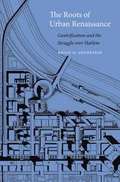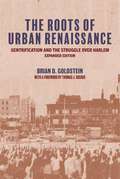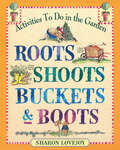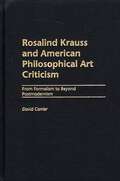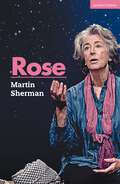- Table View
- List View
Room Acoustics
by Heinrich KuttruffWell established as a classic reference and specialised textbook, since its first publication in 1973, Heinrich Kuttruff’s Room Acoustics combines detailed coverage with a state of art presentation of the theory and practice of sound behaviour in closed spaces. This sixth edition presents several additional new sections, for instance on the reflection of a spherical wave from a wall, on finite element methods for sound field calculation and on virtual reality, as well as giving an overhaul of the standard material. Particular emphasis is given to the properties and calculation of reverberation, the most obvious acoustical feature of a room. And further key topics include the various mechanisms of sound absorption and their practical application as well as scattering by wall irregularities including pseudo-stochastic structures. Extensive space is given to of psychoacoustic insights and the quality criteria derived from them, along with new procedures for the sensory assessment of concert hall acoustics. As in earlier editions, one full and updated chapter is devoted to the design and performance of electroacoustic systems which nowadays is not just a method for sound amplification but offers many possibilities for correcting acoustic deficiencies and modifying a hall’s natural acoustics.
The Room Planner: Over 100 practical plans for your home
by Paula Robinson Phil RobinsonMost of us want to improve our homes and to increase their value at the same time, but very few of us have the money to spend on a professional architect. In Room Planner designer Paula Robinson gives you all the ideas and practical information you need to adapt the space in which you live. The book features over 100 clear, colour-coded plans allowing you to pick and choose layouts and designs according to what's appropriate for your home, whether you have a bedsit or a five-bedroom house. To reflect changing lifestyles, the emphasis is very much on versatility and flexibility, with chapters on High-performance space (making maximum use of available space), Valuable space (dividing space to create additional rooms and increase property value), Flexible space (creating moveable partitions) and Individual space (innovative solutions for particular rooms). There's also basic advice and tips, including: Using colour in the home: blue helps to focus the mind and intellect; green has harmonious, soothing effects; yellow stimulates and invigorates; orange stimulates the appetite.Using shapes: the kidney shape brings a softness and flexibility to interiors; circles introduce a sense of freedom and space.Creating atmosphere: an inset fire set higher up in the wall can have a stunning effect; backlit cupboard doors draw the eye; concealed lighting introduces mood and atmosphere while creating a sense of depth; mirroring the wall opposite the entrance door can bring life and character to a property.This is an essential manual not only for homeowners seeking to rethink their living space, but also for those who are building their home from scratch. Paula and Phil's guide will inspire in you the confidence and enthusiasm to maximise the potential of your living space, so that you too can create your dream home.
The Room & The Dumb Waiter: The Birthday Party; The Room; The Dumb Waiter; A Slight Ache; The Hothouse; A Night Out; The Black And White; The Examination (Pinter Plays Ser.)
by Harold PinterThe Room and The Dumb WaiterIn these two early one-act plays, Harold Pinter reveals himself as already in full control of his unique ability to make dramatic poetry of the banalities of everyday speech and the precision with which it defines character.'Harold Pinter is the most original writer to have emerged from the "new wave" of dramatists who gave fresh life to the British theatre in the fifties and early sixties.' The Times
Rooms in Dramatic Realism
by Fred Miller RobinsonDramatic Realism, since its birth in the hectic late years of the nineteenth century, gave theatrical and thematic energy to the interaction between a play’s text and the way that it looked on the stage. Characters began to find themselves in rooms and settings that played an active and changing role in the drama, and their dialogue and reactions evolved in time with these changes. As life itself became more elaborate during the 20th Century, so these rooms were invaded and then defined by the outside world. Fred Miller Robinson’s enjoyable and stimulating essays on this enduring genre tackle the dreams and anxieties of the middles classes of the Industrial Revolution – dreams of domestic comfort and refuge, and anxieties about how entrapping that comfort could be. Moving from Ibsen to Chekhov and onwards into later plays in which the reality of ‘Realism’ comes under scrutiny, this is a book to dip into before a performance or to study during a class.
Rooms in Dramatic Realism
by Fred Miller RobinsonDramatic Realism, since its birth in the hectic late years of the nineteenth century, gave theatrical and thematic energy to the interaction between a play’s text and the way that it looked on the stage. Characters began to find themselves in rooms and settings that played an active and changing role in the drama, and their dialogue and reactions evolved in time with these changes. As life itself became more elaborate during the 20th Century, so these rooms were invaded and then defined by the outside world. Fred Miller Robinson’s enjoyable and stimulating essays on this enduring genre tackle the dreams and anxieties of the middles classes of the Industrial Revolution – dreams of domestic comfort and refuge, and anxieties about how entrapping that comfort could be. Moving from Ibsen to Chekhov and onwards into later plays in which the reality of ‘Realism’ comes under scrutiny, this is a book to dip into before a performance or to study during a class.
Rootedness: Reflections for Young Architects
by Juhani Pallasmaarootedness Discover the insights and lessons of architect Juhani Pallasmaa In Rootedness: Reflections for Young Architects, Juhani Pallasmaa delivers an insightful and expansive collection of his most compelling ideas into architecture’s position among arts and culture. Pallasmaa speaks to architecture students and young professionals, discussing each topic with sincerity and openness, suggesting what can be learned from areas of culture beyond the boundaries of familiar professional disciplines. He outlines the growing need for an architecture based in self-awareness, reconnection to the environment, and a sense of ethical responsibility. Each essay in Rootedness was initially conceived and presented as an educational lecture and has been carefully edited with clarifications, refinements, and valuable expansions. Accompanying sketches by the author emphasize the personal and intimate nature of the essays. The book also includes: Explorations of perception, creative practice, and the need for an ethical stance Thoughts, meditations, and challenges emerging from the author’s search for identity and purpose in his architectural work A wealth of references within the essays, as well as recommendations for books and films from which readers may draw further inspiration Designed for students of architecture at any age, Rootedness: Reflections for Young Architects will also inspire professional architects, designers, and those in other creative professions.
Rootedness: Reflections for Young Architects
by Juhani Pallasmaarootedness Discover the insights and lessons of architect Juhani Pallasmaa In Rootedness: Reflections for Young Architects, Juhani Pallasmaa delivers an insightful and expansive collection of his most compelling ideas into architecture’s position among arts and culture. Pallasmaa speaks to architecture students and young professionals, discussing each topic with sincerity and openness, suggesting what can be learned from areas of culture beyond the boundaries of familiar professional disciplines. He outlines the growing need for an architecture based in self-awareness, reconnection to the environment, and a sense of ethical responsibility. Each essay in Rootedness was initially conceived and presented as an educational lecture and has been carefully edited with clarifications, refinements, and valuable expansions. Accompanying sketches by the author emphasize the personal and intimate nature of the essays. The book also includes: Explorations of perception, creative practice, and the need for an ethical stance Thoughts, meditations, and challenges emerging from the author’s search for identity and purpose in his architectural work A wealth of references within the essays, as well as recommendations for books and films from which readers may draw further inspiration Designed for students of architecture at any age, Rootedness: Reflections for Young Architects will also inspire professional architects, designers, and those in other creative professions.
Roots (Modern Classics)
by Arnold WeskerIt's 1958. Beatie Bryant has been to London and fallen in love with Ronnie, a young socialist. As she anxiously awaits his arrival to meet her family at their Norfolk farm, her head is swimming with new ideas. Ideas of a bolder, freer world which promise to clash with their rural way of life.Roots is the remarkable centrepiece of Wesker's seminal post-war trilogy. It was first performed in 1959 at the Belgrade Theatre, Coventry, before transferring to the Royal Court. It is the second play in a trilogy comprising Chicken Soup with Barley and I'm Talking About Jerusalem. It went on to transfer to the Duke of York's Theatre in the West End.A true classic, Roots is an affecting portrait of a young woman finding her voice at a time of unprecedented social change. This Modern Classic edition features an introduction by Glenda Leeming.
Roots: Roots, Sergeant Musgrave's Dance, Early Morning, Loot, The Ruling Class (Modern Classics)
by Arnold WeskerIt's 1958. Beatie Bryant has been to London and fallen in love with Ronnie, a young socialist. As she anxiously awaits his arrival to meet her family at their Norfolk farm, her head is swimming with new ideas. Ideas of a bolder, freer world which promise to clash with their rural way of life.Roots is the remarkable centrepiece of Wesker's seminal post-war trilogy. It was first performed in 1959 at the Belgrade Theatre, Coventry, before transferring to the Royal Court. It is the second play in a trilogy comprising Chicken Soup with Barley and I'm Talking About Jerusalem. It went on to transfer to the Duke of York's Theatre in the West End.A true classic, Roots is an affecting portrait of a young woman finding her voice at a time of unprecedented social change. This Modern Classic edition features an introduction by Glenda Leeming.
Roots & Culture: Cultural Politics in the Making of Black Britain (International Library of Cultural Studies)
by Eddie ChambersHow did a distinct and powerful Black British identity emerge? In the 1950s, when many Caribbean migrants came to Britain, there was no such recognised entity as “Black Britain.” Yet by the 1980s, the cultural landscape had radically changed, and a remarkable array of creative practices such as theatre, poetry, literature,South Sudan in War and Peace music and the visual arts gave voice to striking new articulations of Black-British identity.
The Roots of My Obsession: Thirty Great Gardeners Reveal Why They Garden
by Thomas C. CooperWhy would any sane person spend hours on hands and knees, courting aching joints and a ruined back, just to raise a bunch of plants? A rich, complex, and human answer can be found in the pages of The Roots of My Obsession.
The Roots Of Romanticism: Conferencias A. W. Mellon En Bellas Artes, 1965, The National Gallery Of Art, Washington Dc (A. W. Mellon Lectures In The Fine Arts Ser. #179)
by Isaiah BerlinThe Roots of Romanticism is the long-awaited text of Isaiah Berlin's most celebrated set of lectures, the Mellon Lectures, delivered in Washington in 1965 and heard since by a much wider audience on BBC radio. For Berli, the Romantics set in train a vast, unparalleled revolution in humanity's view of itself. They destroyed the traditional notion of objective truth in ethicsm with incalculable, all-pervasive results. In his unscripted tour de force Berlin surveys the myriad attempts to define romanticism, distils its essence, traces its development, and shows how its legacy permeates our outlook today.
The Roots of Romanticism: Second Edition (The A. W. Mellon Lectures in the Fine Arts #45)
by Isaiah BerlinA brilliant brief account of romanticism and its influence from one of the most important philosophers and intellectual historians of the twentieth centuryIn The Roots of Romanticism, one of the twentieth century's most influential philosophers dissects and assesses a movement that changed the course of history. Brilliant, fresh, immediate, and eloquent, these celebrated Mellon Lectures are a bravura intellectual performance. Isaiah Berlin surveys the many attempts to define romanticism, distills its essence, traces its developments from its first stirrings to its apotheosis, and shows how it still permeates our outlook. He ranges over a cast of some of the greatest thinkers and artists of the eighteenth and nineteenth centuries, including Kant, Rousseau, Diderot, Schiller, the Schlegels, Novalis, Goethe, Blake, Byron, and Beethoven. The ideas and attitudes of these and other figures, Berlin argues, helped to shape twentieth-century nationalism, existentialism, democracy, totalitarianism, and our ideas about heroic individuals, self-fulfillment, and the exalted place of art.This new edition, illustrated for the first time, also features a new foreword by philosopher John Gray, in which he discusses Berlin's belief that the influence of romanticism has been unpredictable and contradictory in the extreme, fuelling anti-liberal political movements but also reinvigorating liberalism; a revised text; and a new appendix that includes some of Berlin's correspondence about the lectures and the reactions to them.
The Roots of Romanticism: Second Edition
by Isaiah Berlin Henry Hardy John GrayIn The Roots of Romanticism, one of the twentieth century's most influential philosophers dissects and assesses a movement that changed the course of history. Brilliant, fresh, immediate, and eloquent, these celebrated Mellon Lectures are a bravura intellectual performance. Isaiah Berlin surveys the many attempts to define romanticism, distills its essence, traces its developments from its first stirrings to its apotheosis, and shows how it still permeates our outlook. He ranges over a cast of some of the greatest thinkers and artists of the eighteenth and nineteenth centuries, including Kant, Rousseau, Diderot, Schiller, the Schlegels, Novalis, Goethe, Blake, Byron, and Beethoven. The ideas and attitudes of these and other figures, Berlin argues, helped to shape twentieth-century nationalism, existentialism, democracy, totalitarianism, and our ideas about heroic individuals, self-fulfillment, and the exalted place of art. This new edition, illustrated for the first time, also features a new foreword by philosopher John Gray, in which he discusses Berlin's belief that the influence of romanticism has been unpredictable and contradictory in the extreme, fuelling anti-liberal political movements but also reinvigorating liberalism; a revised text; and a new appendix that includes some of Berlin's correspondence about the lectures and the reactions to them.
The Roots of Romanticism: Second Edition
by Isaiah Berlin Henry Hardy John GrayIn The Roots of Romanticism, one of the twentieth century's most influential philosophers dissects and assesses a movement that changed the course of history. Brilliant, fresh, immediate, and eloquent, these celebrated Mellon Lectures are a bravura intellectual performance. Isaiah Berlin surveys the many attempts to define romanticism, distills its essence, traces its developments from its first stirrings to its apotheosis, and shows how it still permeates our outlook. He ranges over a cast of some of the greatest thinkers and artists of the eighteenth and nineteenth centuries, including Kant, Rousseau, Diderot, Schiller, the Schlegels, Novalis, Goethe, Blake, Byron, and Beethoven. The ideas and attitudes of these and other figures, Berlin argues, helped to shape twentieth-century nationalism, existentialism, democracy, totalitarianism, and our ideas about heroic individuals, self-fulfillment, and the exalted place of art. This new edition, illustrated for the first time, also features a new foreword by philosopher John Gray, in which he discusses Berlin's belief that the influence of romanticism has been unpredictable and contradictory in the extreme, fuelling anti-liberal political movements but also reinvigorating liberalism; a revised text; and a new appendix that includes some of Berlin's correspondence about the lectures and the reactions to them.
The Roots of Urban Renaissance: Gentrification And The Struggle Over Harlem
by Brian D. GoldsteinIn charting the growth of gleaming shopping centers and refurbished brownstones in Harlem, Brian Goldstein shows that gentrification was not imposed on an unwitting community by opportunistic developers or outsiders. It grew from the neighborhood’s grassroots, producing a legacy that benefited some longtime residents and threatened others.
The Roots of Urban Renaissance: Gentrification And The Struggle Over Harlem
by Brian D. GoldsteinIn charting the growth of gleaming shopping centers and refurbished brownstones in Harlem, Brian Goldstein shows that gentrification was not imposed on an unwitting community by opportunistic developers or outsiders. It grew from the neighborhood’s grassroots, producing a legacy that benefited some longtime residents and threatened others.
The Roots of Urban Renaissance: Gentrification and the Struggle over Harlem, Expanded Edition
by Brian D. GoldsteinAn acclaimed history of Harlem’s journey from urban crisis to urban renaissanceWith its gleaming shopping centers and refurbished row houses, today’s Harlem bears little resemblance to the neighborhood of the midcentury urban crisis. Brian Goldstein traces Harlem’s Second Renaissance to a surprising source: the radical social movements of the 1960s that resisted city officials and fought to give Harlemites control of their own destiny. Young Harlem activists, inspired by the civil rights movement, envisioned a Harlem built by and for its low-income, predominantly African American population. In the succeeding decades, however, the community-based organizations they founded came to pursue a very different goal: a neighborhood with national retailers and increasingly affluent residents. The Roots of Urban Renaissance demonstrates that gentrification was not imposed on an unwitting community by unscrupulous developers or opportunistic outsiders. Rather, it grew from the neighborhood’s grassroots, producing a legacy that benefited some longtime residents and threatened others.
Roots, Shoots, Buckets & Boots: Gardening Together with Children
by Sharon LovejoyRoots, Shoots, Buckets & Boots features 12 spirited, easy-to-implement ideas for theme gardens that parents and kids can grow together.
Rope: A Novel (Drama Ser.)
by Patrick HamiltonThe brilliantly tense play that became Hitchcock's masterpiece, starring James Stewart.Believing themselves to be intellectually superior to their contemporaries, flatmates Brandon and Philip murder their friend David Kentley purely to see if they can get away with it. They then throw a cocktail party, serving food from the top of the trunk where they have hidden David's body. Their guests include both David's father and fiancée, as well as college lecturer Rupert Cadell, who becomes increasingly suspicious as the evening wears on.
Rosalind Krauss and American Philosophical Art Criticism: From Formalism to Beyond Postmodernism (Non-ser.)
by David CarrierRosalind Krauss is, without visible rival, the most influential American art writer since Clement Greenberg. Together with her colleagues at ^IOctober^R, the journal she co-founded, she has played a key role in the introduction of French theory into the American art world. In the 1960s, though first a follower of Greenberg, she was inspired by her readings of French structuralist and post-structuralist materials, revolted against her mentor's formalism, and developed a succession of radically original styles of art history writing. Offering a complete survey of her career and work, ^IRosalind Krauss and American Philosophical Art Criticism: From Formalism to Beyond Postmodernism^R comprises the first book-length study of its subject.Written in the lucid style of analytic philosophy, this accessible commentary offers a consideration of her arguments as well as discussions of alternative positions. Tracing Krauss's development in this way provides the best method of understanding the changing styles of American art criticism from the 1960s through the present, and thus provides an invaluable source of historical and aesthetic knowledge for artists and art scholars alike.
Rose: Cracks; Bent; Messiah; Rose (Modern Plays)
by Martin ShermanThis powerful one-woman play is a moving reminder of some of the harrowing events that shaped the century and remains sadly relevant today with racial tensions and allegations of antisemitism continuing to dominate the news.Blending the personal with the political, this sharply drawn portrait of a feisty Jewish woman traces Rose's story from the devastation of Nazi-ruled Europe to conquering the American dream. Rose reflects on what it means to be a survivor. Her remarkable life began in a tiny Ukrainian village, took her to Warsaw's ghettos and a ship called The Exodus, and finally to the boardwalks of Atlantic City, the Arizona canyons, and salsa-flavoured nights in Miami beach.This revised edition was published to coincide with the new production at London's Park Theatre starring Maureen Lipman as Rose.
Rose (Modern Plays)
by Martin ShermanThis powerful one-woman play is a moving reminder of some of the harrowing events that shaped the century and remains sadly relevant today with racial tensions and allegations of antisemitism continuing to dominate the news.Blending the personal with the political, this sharply drawn portrait of a feisty Jewish woman traces Rose's story from the devastation of Nazi-ruled Europe to conquering the American dream. Rose reflects on what it means to be a survivor. Her remarkable life began in a tiny Ukrainian village, took her to Warsaw's ghettos and a ship called The Exodus, and finally to the boardwalks of Atlantic City, the Arizona canyons, and salsa-flavoured nights in Miami beach.This revised edition was published to coincide with the new production at London's Park Theatre starring Maureen Lipman as Rose.
Rose Window - Rennie Mackintosh (large print)
by RnibThis page shows a stained glass window based on a design by Scottish architect Charles Rennie Mackintosh. There is a locator dot shown, which will be at the top left of the page when the image is the correct way up. This window panel is made from leaded stained glass. This technique uses pieces of coloured glass held together by thin strips of lead. At the top left of the design is a stylised rose flower with red and pink petals. It is constructed of overlapping curves and at its centre is a grid of small rectangles. The stem of the rose is represented by an oval shape, which curves down from the rose shape to the bottom of the image then up right and then left to the top of the rose. Across the centre of the image is a horizontal band with horizontal lines to the left and right. The background of the design is very pale green and the band is coloured pale mauve with a green section where the stem crosses the band on the left and a blue section on the right. Mackintosh lived from 1868 to 1928. He was connected to both the Arts and Crafts, and the Art Nouveau movements although his very distinctive graceful and elegant style in some ways foreshadows the later modern style of Art Deco.
Rose Window - Rennie Mackintosh (UEB contracted)
by RnibThis page shows a stained glass window based on a design by Scottish architect Charles Rennie Mackintosh. There is a locator dot shown, which will be at the top left of the page when the image is the correct way up. This window panel is made from leaded stained glass. This technique uses pieces of coloured glass held together by thin strips of lead. At the top left of the design is a stylised rose flower with red and pink petals. It is constructed of overlapping curves and at its centre is a grid of small rectangles. The stem of the rose is represented by an oval shape, which curves down from the rose shape to the bottom of the image then up right and then left to the top of the rose. Across the centre of the image is a horizontal band with horizontal lines to the left and right. The background of the design is very pale green and the band is coloured pale mauve with a green section where the stem crosses the band on the left and a blue section on the right. Mackintosh lived from 1868 to 1928. He was connected to both the Arts and Crafts, and the Art Nouveau movements although his very distinctive graceful and elegant style in some ways foreshadows the later modern style of Art Deco.

